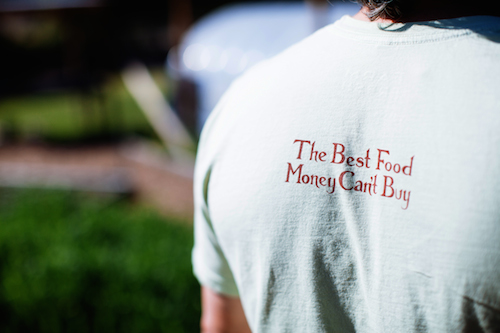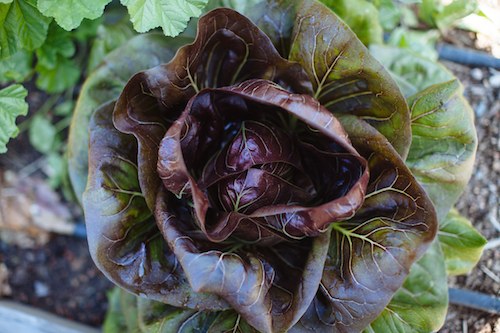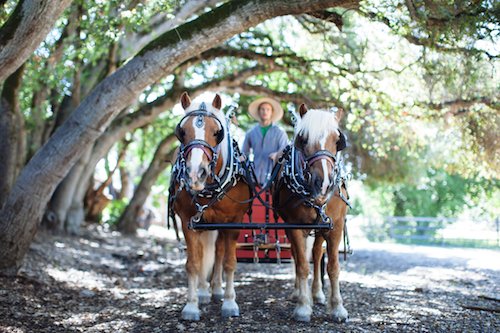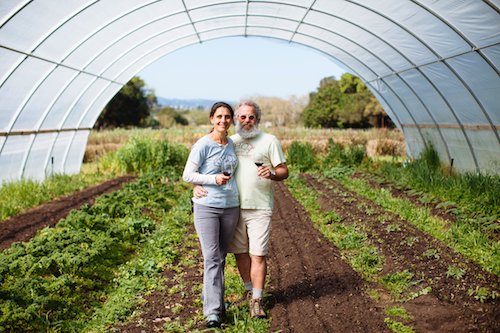WHOA Farms makes wine in order to give food away.
According to Sonoma County’s strangely riveting official document, “Obesity Prevention Plan, 2010-2013,” a 2,000-calorie-a-day diet consisting of calorie-dense foods costs the local consumer $3.52. The average American eats a range of foods at that calorie level costing roughly $7 a day. But the price of a diet providing the same amount of daily energy but composed solely of low-calorie, high-nutrient foods? $36.32. A day.
Something’s got to give.
With an estimated 40 percent of Sonoma County adolescents now categorized as obese, food cost and health education have never been more important. Smack amid our bucolic rural paradise, where some of the best food in the United States is grown, our youngest community has never been less well-fed. Blame fast food, blame the economy, blame the 1 percent—cast blame all around. It won’t do any good. Action is the only answer.
At least that’s how Eddie Gelsman and his wife Wendy Mardigian see it. And they have certainly put their money where our mouths are.
Gelsman and Mardigian own and operate WHOA Farm, a 501c3 nonprofit whose motto is, “The Best Food Money Can’t Buy!”
You can’t buy it, because they give it away. Last year, they gave away 40,000 pounds of produce and 12,000 dozen chicken eggs at an estimated cost of $150,000. They employ five full time employees at WHOA, including a couple who live on the Petaluma Hill Road property with their toddler daughter and work the kinds of hours that farmers always have—that is, all the time.
Gelsman is a successful rare wine broker who co-owns Petaluma’s Wine Library with his brother Carl. Mardigian was a stay-at-home mom of their two young sons who started a terraced vegetable garden on their home property as a “hobby,” she says, to keep busy when the boys were little. Turns out, she grew more than just food; her hobby launched a new branch of philanthropy in the family.
“We were growing vegetables and fruits and realized that we had an abundance that we couldn’t possibly eat ourselves,” Mardigian says, standing on one of WHOA’s five-acre lots on a brilliant early spring day. “The ‘aha’ moment for us was when we realized that there are agencies—Redwood Empire Food Bank, St. Vincent de Paul—that would take the food. I realized how easy it was to do that. To just give it away! We had too many tomatoes, too much zucchini. We realized that Sonoma County is a place where it’s really easy to help, where we can lend a hand with food. It just awakened us to this other level of community service going on and the institutions that were already built and ready to take it. They facilitated for us this idea of giving the food away.”
WHOA’s current beneficiaries are the Santa Rosa Health Center, the Forestville Wellness Center, the Ceres Project, and the St. Vincent de Paul dining room. The couple deliver the produce themselves each day during the growing season, taking pride in harvesting food in the morning that will be eaten that night.
WHOA Farm consists of 16 acres of vegetables and hay, 11 acres of Pinot Noir grapes leased from the Crane family—whose melon barn is in the middle of the spread—and an additional 800 acres across the street waiting to someday be planted. WHOA is no longer a dream, it’s a full-on operation. A damned expensive one.
After five years of funding the whole nonprofit themselves, Gelsman and Mardigian are avidly awaiting the release of their 2012 WHOA Farm Pinot Noir. Guy Davis of Davis Family Vineyards has volunteered to be their wine-maker and the couple anticipates that 600 cases will be ready for sale this fall.
It just awakened us to this other level of community service going on and the institutions that were already built and ready to take it. Wendy Mardigian
“One of the other big things that we realized early on, and what we’re in many ways trying to be a model for, is to be able to pay for something like this in a non-farming way,” Gelsman says. “We turned to what we know best, which is wine sales.”
Tentatively priced between $35-$40 a bottle, sales of WHOA Farm Pinot might, just maybe, provide half of the farm’s operating costs.
“If our projections are right, it might even cover more than that,” Gelsman says, “because we can certainly increase our production as time allows. This is about everybody’s opportunity, not only in Sonoma County, to support what we’re doing by buying the wine, but all over the state of California and the United States, as well as internationally. Napa may be the Big Brother, but Sonoma County is right there behind it in terms of international recognition and right there behind it, certainly, in terms of need.
“So,” he continues, “that is the reason that we went to wine. It’s what I’ve been doing for 20-plus years. There are a lot of people who want to step forward and help us do something about it. We’re going to give this a life of its own.”
The farm’s acronym stands for Work Horse Organic Agriculture, and indeed, Gelsman and Mardigian employ two Haflinger draft horses to plow their fields as part of their focus on sustainable farming.
“WHOA, by its name, implies slowing down,” Gelsman explains. “To slow down, we use fundamental aspects of farming that maybe are not the most effective time-wise, but rather, treat the land and environment with what it needs at this time. Horses are a wonderful part of that. It’s a wonderful cycle of using them efficiently without expending any fossil fuel.”
Gelsman and Mardigian are optimistic that they will be able to interest other deep-pocketed folks in helping to support the farm.
“Nothing’s really aggressive around here,” Gelsman smiles, “but we are more aggressively going out into the community, finding out what donor money might be available, utilizing the skills that we have among our group of friends. The idea is to get this to be self-supporting, whether that comes from grants or from endowments.”
And they’re positive that the wine will be a hit.
“This is not a gigantic big fruit bomb,” Gelsman says of the barrels he’s tasted. “I basically make a living selling European wines here in the U.S. This is more of a Burgundian style, it has a lot of finesse, it’s very elegant, and it’s an easy drinking wine.”
Wine sales will be from the WHOA Farm website, a few select retailers, and some area restaurants. While 100 percent of the online proceeds will benefit WHOA, Gelsman says that retailers and restaurateurs have agreed to take a lesser mark-up to support the nonprofit’s efforts.
There are lots of problems in the world and at home, but not everyone purchases land, hires employees, grows food simply with the intention of donating it, and makes wine to try to pay for it. Why WHOA?
“I’m a product of the 1960s and ’70s,” Gelsman says. “My roots are based in Students for a Democratic Society, protesting wars in foreign places. I’ve fought a lot of battles in my lifetime, but was time for me to sink my teeth into one that was local, that was right here in our community, because the need is so imminent. We have a gigantic juvenile diabetes rate, that’s a massive problem right now.”
Mardigian adds, “That knowledge came to us at the same time we realized that it was possible to give this food away. We thought, ‘What is going on? This is a ridiculous epidemic!’”
Gelsman shakes his head. “For those of us who eat well every day, to think that this is just some sort of a problem that we can just turn our heads away from, well—it is happening and it’s getting worse.
“Are we going to make this problem go away?” he asks rhetorically. “No. But can we contribute in some way, either big or small, to a positive outcome? We certainly can. Then, if somebody else can come and see what we’re doing and figure it out—it doesn’t have to be wine, it can be something else—one always likes to think of the goodness of the community spirit. Not everyone can write a check, but people can give of their time.”
He glances at his wife.
“We’re just two people, but we do believe that charity starts at home.”




